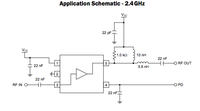robismyname
Full Member level 6
- Joined
- Jan 17, 2008
- Messages
- 390
- Helped
- 11
- Reputation
- 22
- Reaction score
- 9
- Trophy points
- 1,298
- Location
- Central Florida
- Activity points
- 4,603
Is there a book/white paper that discusses LNA measurements (2.4 GHz applications)? In particular.......
1) Measure LNA gain
2) Measure LNA input impedance
3) Measure LNA output impedance
4) Measure LNA noise figure
5) Measure LNA linearity
6) Measure LNA P1dB
7) Measure LNA BW
8) Measure LNA unconditional stability
Need some resources (books, whitepapers/application notes, URL's) on how to do the above measurements properly.
1) Measure LNA gain
2) Measure LNA input impedance
3) Measure LNA output impedance
4) Measure LNA noise figure
5) Measure LNA linearity
6) Measure LNA P1dB
7) Measure LNA BW
8) Measure LNA unconditional stability
Need some resources (books, whitepapers/application notes, URL's) on how to do the above measurements properly.
